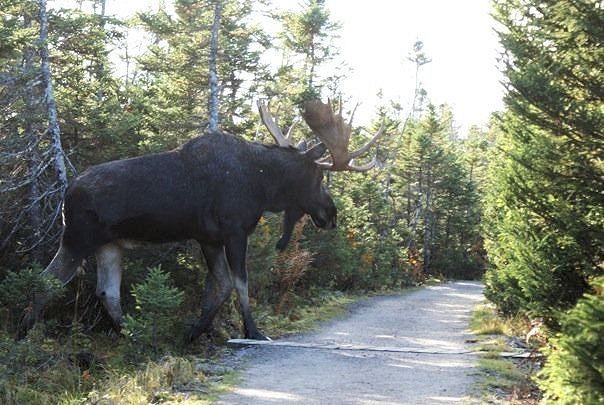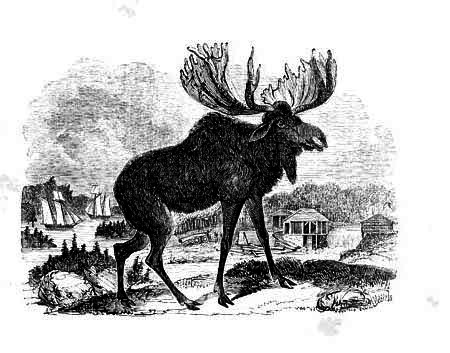The moose in the above photo is, according to the caption, going for a stroll on Calais’ waterfront walkway. As one who often jogs on the walkway, I confess I have never encountered this or any other moose on the walkway, but it is likely a moose would from time to time seek the refreshing water of the St. Croix. Certainly, deer find their way to the river in droves these days, often blocking Union Street as they pass.
The moose is a magnificent animal, statuesque and, in the opinion of many, even endowed with a certain nobility. The largest land mammal in North America and Europe in stature if not weight (the bison and brown bear weigh more) the moose has come to define the State of Maine in the mind’s eye of both locals and those “from away”. Only the lobster can provide competition for the moose, perhaps because it can be made palatable by dipping it in butter, but lobsters are ugly creatures, swimming listlessly in tanks in every grocery store in the state while awaiting their fate in boiling water. This may be the reason it is the moose and not the lobster which adorns our state flag.
Not usually inclined to consort with humans, the moose is a solitary and elusive animal which lives primarily in the deep woods. Contact with a moose in the wild is a rare event. I sometimes stop at the Whale’s Back turnout when driving the airline to admire the view over Union River. Some years ago, I fell into conversation with a couple I found staring intently and with purpose into the distance. When asked what they were looking for, they answered, “a moose” and confessed they had never seen one and had heard this was a good place to see a moose. They were in their late 60’s and I assumed they were from away, but they had, in fact, lived their entire lives in Jonesboro.
Henry David Thoreau the renowned naturalist and recluse rarely ventured from his hideaway on Walden Pond. The only exceptions were several trips to the wilds of Maine on which Thoreau based his classics “The Maine Woods.” For Thoreau the Maine woods were symbolized by Indians, pine trees and the moose. He felt the killing of “these big, gentle, myopic creatures” is more “like going out by night to some woodside pasture and shooting your neighbor’s horses.” He did accept it was necessary for the Indians to kill moose to survive but only grudgingly. His dying words were “Now comes the good sailing” followed by “Indian” and “Moose”.
Knowlton in the first history of the St. Croix Valley in 1876 describes the valley before the coming of the Europeans:
A hundred years ago, and during scores of previous centuries, all the territory in and around Calais and St. Stephen was a sombre wilderness. The lakes slept in their earthen beds, and the wide-awake rivers hurried along their winding paths, as they do now; but all the hills and valleys were completely covered and rounded into beauty by a dense forest. Pine, Spruce, Fir, Cedar, Hemlock, Oak, Ash, Beech, Birch, Maple, Poplar and Elm trees, many of them very large and tall, grew luxuriantly where are now our meadows, streets and gardens. Here and there in sunny openings, the Blueberry, Whortleberry, Raspberry and Gooseberry, ripened their delicious fruits. The Moose and Deer, the Bear and Caribou, the Wolf and Fox, the Loup-cervier and Catamount, the Rabbit and Squirrel, roamed through the pathless woods, unmolested and happy. The Beaver, Otter, Mink and Muskrat, on the banks of every lake and river, built their homes and reared their offspring, in peace. Geese, ducks, partridges, pigeons and hosts of smaller birds winged the air and made the Summer joyful with their melody, in countless numbers, Salmon, Shad and Alewives sported in the water.
We know, of course, that the moose did not come to North America on the Mayflower. To the contrary, moose had roamed the Northeast for thousands of years before the arrival of the white man and had been an important staple in the diet of Native Americans for thousands of years. The moose hunt in the winter when the ungainly animal’s long legs sank further in the snow than their snowshoed pursuers was a primary source of sustenance for Native Americans. Lacking firearms, they sometimes hunted moose with a moose lance- a long-pointed bone lashed to a long shaft. When there was no snow small groups of Wabanaki men would follow the track of a moose sometimes for days until the moose was within range of their bows. Volley after volley would be launched, sometimes over several days, until the moose finally succumbed. In Micmac culture a boy was deemed a man after he had killed his first moose.
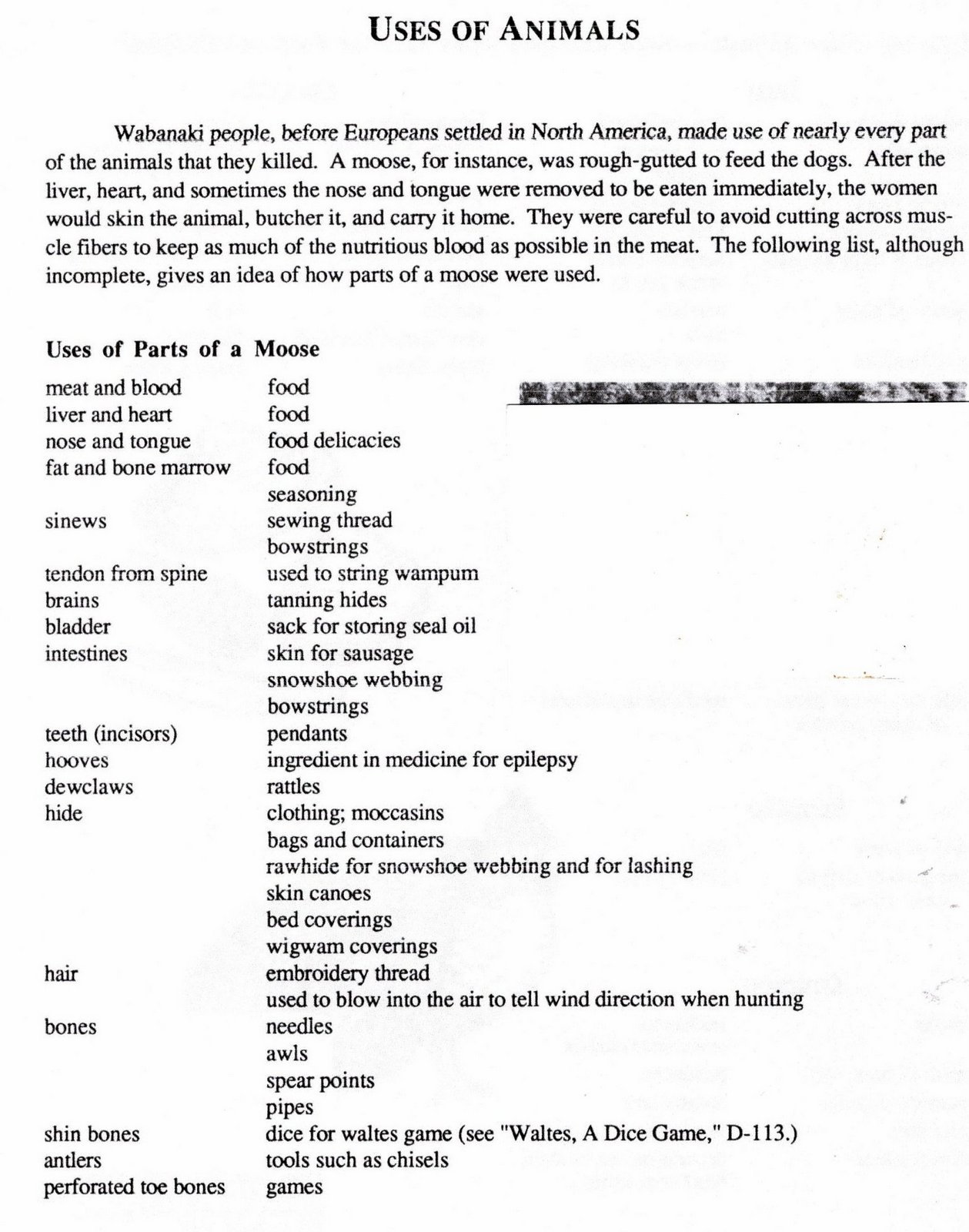
The Micmacs found a use for every part of the moose
A successful winter hunt not only for moose but caribou and deer was critical to the tribe. Without the sustenance provided by these animals during winter starvation decimated the tribe. This was the case during the bitter winter of 1604-1605 when Demonts and Champlain wintered on St. Croix Island and nearly half the French settlers succumbed to scurvy and starvation. The tribes on the shore suffered proportionally and could do nothing to help the Frenchmen because they could not feed themselves.
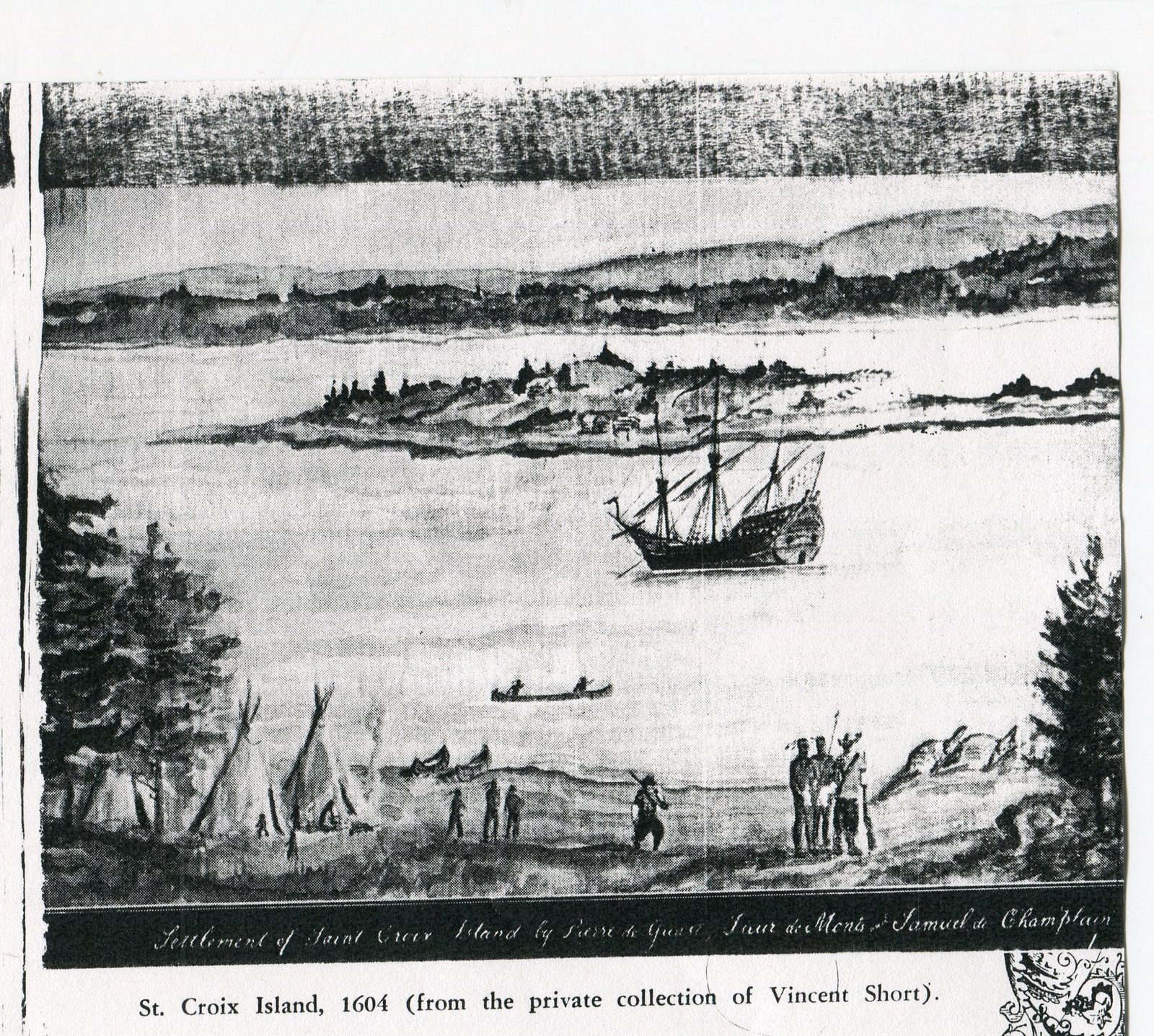
During the bitter winter of 1604-1605 even the natives suffered from starvation
Although they did not realize it at the time the French landing at St. Croix Island in 1604 was a portent of disaster for both the natives in the St. Croix Valley and its fauna including the moose. When white settlers arrived in large numbers in the 1700’s they brought with them weapons that could kill even large animals like the moose from great distances, sometimes with a single shot. The settlers also claimed exclusive possession of large tracts of land which were formerly tribal hunting grounds. Caribou disappeared entirely from the region and deer and moose populations declined dramatically. Noted local historian Ned Lamb of Milltown writing in the 1930’s pulls no punches:
This well-known human race is the most destructive animal on the face of the earth. This applies particularly to the white race. Wherever they go everything falls before them. The Aurochs, perhaps a new word to some, were large bison of Europe, and are gone like our bison, or miscalled Buffalo, which once roamed by the millions across the west, but only samples are left in a few parks. To set nearer home, the moose or American Elk, has almost disappeared from our forests, along with our Woods Caribou. (Maguerrowoc–Caribou lake). Fifty years ago the deer had been almost wiped out around here.
In an article in the Calais Times in the 1880s a writer describes visiting a logging camp near Princeton in 1831.
I remained at the camps a week. The lumber was large pine, and the best was made into square timber for the English market. No small pine, spruce or hemlock was cut. One man was employed to look up the timber and to hunt moose to feed the men. There were no deer in the woods; none had been seen for several years. It was said the wolves had destroyed them.
Richard Hayden, who lived in Robbinston from 1821 until the Civil War, kept a daily diary which contains a wealth of historical information about this area. He surveyed much of Washington County including Grand Lake Stream. Hayden mentions only occasionally taking a deer or moose. In 1833 he writes of shooting a large moose and the logistical problems of dealing with so much meat. While he was able to have some meat cured at Brooks smoke house in Robbinston he gave away or traded most of the meat, 5 pounds of it for a gallon of rum. He “let an Indian by the name of Lewie” have some of the moose skin to make him some snowshoes and moccasins.
Frontispiece of John Springer’s 1851 book on the Maine Woods
The most informative and interesting book written about the Maine woods in this era is John Springer’s “Forest Life and Trees.” Written in 1851, the book can still be purchased on Amazon. Springer was from Robbinston and spent much of his life working in the woods of eastern Maine and New Brunswick. Forest Life and Trees is a remarkable account of living and working in these woods while they were still mostly virgin forest.
A typical passage:
Arriving at length upon or near the territory to be explored, we haul our bateau safely on shore, and turn it bottom upward. Then, dividing our luggage into parcels, and making use of our blankets for knapsacks, we begin to traverse the wild forests, un-frequented except by the stately moose, the timid deer, the roaming black bear, and other wild animals of less note, whom we frequently disturb in their solitary haunts.
Hobbs, who, by-the-way, was a short, thick-set little fellow, with a chubby red face, and, withal, rather musical in his turn, gave vent to the following beautiful song, dedicated to the “Lumbermen” by the poet Whittier.
“Comrades! round our woodland quarters Sad-voiced autumn grieves;
Thickly down these swelling waters Float his fallen leaves.
Through the tall and naked timber, Column-like and old,
Gleam the sunsets of November With their skies of gold.
O’er us, to the South-land heading,
Screams the gray wild goose;
On the night-frost sounds the treading of the stately moose.
Fast the streams with ice are closing,
Colder grows the sky,
Soon, on lake and river frozen,
Shall our log-piles lie.
Springer has much to say about the “stately moose” in the book. It is also evident that the 1830’s bounty on wolves had done much to reestablish the deer population in the Maine woods.
From Springer: (1851)
A tramp after deer and moose is sometimes taken. We often disturb them in penetrating the deep forests for timber, in such cases they always remove to some more sequestered place, and post themselves for winter-quarters again, where we sometimes follow and take them when the condition of the snow renders their flight tardy and difficult. In the summer they roam at large through the forests and on the meadows, where they may often be seen feeding as we pass up the rivers; but in winter they confine themselves to much smaller limits, where they remain during the greater portion of the season. The flesh of the deer forms an agreeable change from our salt provisions. Venison is often quite plenty. From the hare and partridge our cook serves a delicious pot-pie. The flesh of the moose and bear are very good.
The moose is the largest species of deer found in the New England forest. Their size varies from that of a large pony to the full-grown horse. They have large brandling antlers, which grow and are shed every season.
The taking of moose is sometimes quite hazardous. The most favorable time for hunting them is toward spring, when the snow is deep, and when the warmth of mid-day melts the surface, and the cold nights freeze a crust, which greatly embarrasses the moose and deer in their flight.
The “bull moose” is a formidable foe when he “gets his dander up,” and specially so at particular seasons of the year; then, unprovoked, they will make war on man, betraying none of that shrinking timidity so characteristic of the cervine genus. A hunter, who used to put up occasionally over night at our camp, entertained us with the following singular adventure. “Once,” said he, “while out on a hunting excursion, I was pursued by a ‘bull moose,’ during that period when their jealousy was in full operation on behalf of the female. He approached me with his muscular neck curved, and head to the ground, in a manner not dissimilar to the attitude assumed by horned cattle when about to encounter each other. Just as he was about to make a pass at me, I sprang suddenly between his wide-spreading antlers, bestride his neck. Dexterously turning round, I seized him by the horns, and, locking my feet together under his neck, I clung to him like a sloth. With a mixture of rage and terror, he dashed wildly about, endeavoring to dislodge me; but, as my life depended upon maintaining my position, I clung to him with a corresponding desperation. After making a few ineffectual attempts to disengage me, he threw out his nose, and, laying his antlers back upon his shoulders, which formed a screen for my defense, he sprang forward into a furious run, still hearing me upon his neck. Now penetrating dense thickets, then leaping high “windfalls,” and struggling through swamp-mires, he finally fell through exhaustion, after carrying me about three miles. Improving the opportunity, I drew my hunter’s knife from its sheath, and. instantly buried it in his neck, cutting the jugular vein, which put a speedy termination to the contest and the flight.”
The political fate of local moose and deer in the later part of the 19th century was fought without quarter in the “Downeast Games Wars.” The best history of this conflict is Edward D. Ives’s George Magoon and the Downeast Games Wars. I cannot recommend this book too highly. In summary the opposing forces were on the one hand the locals who relied on game both for sustenance and as income from the sale of meat to Eastern seaboard restaurants against the “sports” and the sporting camp industry which relied on “people from away” to spend large sums of money to secure a trophy head to hang over their fireplace in Boston, New York and Philadelphia.
An article in 1886 in the Calais Times titled “Moose in Maine. An Old Hunter’s Observations-Protective Laws That Come Too Late” summarized the failed effort to protect the moose.
From 1850 to 1860 the number of moose visibly decreased, until it became apparent that unless there was some stop put to the wholesale slaughter, they would soon be entirely annihilated. Public opinion now turned toward our legislature to enact some law to protect the game, and the first law passed was to stop the white man from killing- but allowing the Indian perfect liberty in the premises.
Unfortunately, the moose population continued to decline largely, according to the author, because the Indians took advantage of their monopoly. The author continued:
With this knowledge and because of growing scarcity of game the public became alarmed, and our legislature passed another act- this time to stop the killing of moose for five years by everybody. But this noble game had become so thinned out that even the five-year close time only left us a few scattering animals. One great reason for this was that the sentiment of the people in the backwoods was not schooled up to game laws: the frontiersmen felt that they had a natural right to the game of the forest for a living, and that the law protecting game was more in the interests of the city sportsmen then for their benefit, and so whenever the opportunity presented, he helped himself to what he considered his by the rights of the higher law.
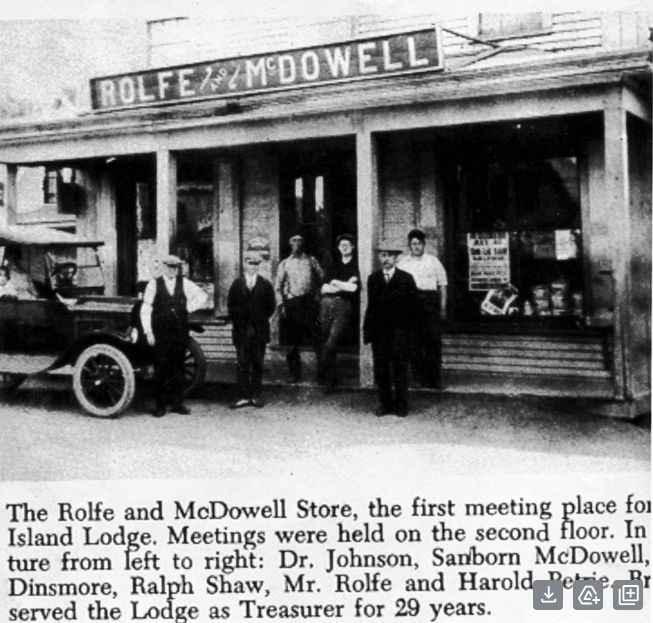
The Rolfe and McDowell Store in Princeton the the 1920s
Local sports were not entirely blameless. Consider the turn of the century game suppers in Princeton: From Belmore’s history of Princeton:
And there were the Game Suppers which for years ranked high in the sporting life of Princeton. The Game Supper Club held its meetings in the hall over Put Rolfe’s store and had for secretary Put’s younger son Fred. Each fall when the game season was on, three days were designated in which to round up the game. The game comprised about everything in the way of wild life that had a habitat in the Princeton area, ranging from the tiny wren to the moose. Each kind of game was listed with its value in points, the points allowed to each being regulated by the difficulty in bagging it. For instance, a partridge might be counted five points, a duck ten, a bear fifty, and so on. Only the heads of the game were required to be brought to the rendezvous as proof of the bag. The members taking part in the hunt were divided into two sides of equal number. No questions were asked as to how the game was procured, whether hunted legitimately, bought, stolen, or otherwise pilfered. It was war and all was fair, provided the heads were produced. A member convivially inclined could get an opposing member drunk and thus put him hors de combat or at least render him unfit to guard his heads. Cy Robbins on one such game hunt went “Below” and bought some game. Naaman Horsman got wind of Cy’s plans and drove down to Baileyville to lie in ambush on a side road. Finally, Cy came along and Naaman trailed him in the dark at a safe distance. When Cy’s horse was laboring up the long winding hill leading from the watering trough up toward Redding’s and Cy was singing lustily to keep himself company, Naaman sneaked up behind and extricated Cy’s game; and Cy kept on singing blissfully until he reached the Princeton House and went to deliver his boodle for credit
In the contest the side that scored the lower number of points was obliged to pay for the supper for the whole club. Taking a realistic view of the species Homo, this truly was a manly sport but one hard on the game. Indeed, the drain on the wildlife in the section in time came to be so great that the authorities had to step in and put an end to it; and so the club went out of existence, leaving only the fragrance of things that were.
IIn the late 1800’s a limit of three deer and one moose per person was imposed. The limit was later reduced to two deer while the hunting of moose was severely restricted. These limits were political minefields with pols forced to contend with the conflicting interests of “sports” and the “locals”. Commercial interests like the Washington County Railroad had to walk a fine line. As early as 1900 the Washington County Railroad in its advertising brochure had this to say about the Maine moose:
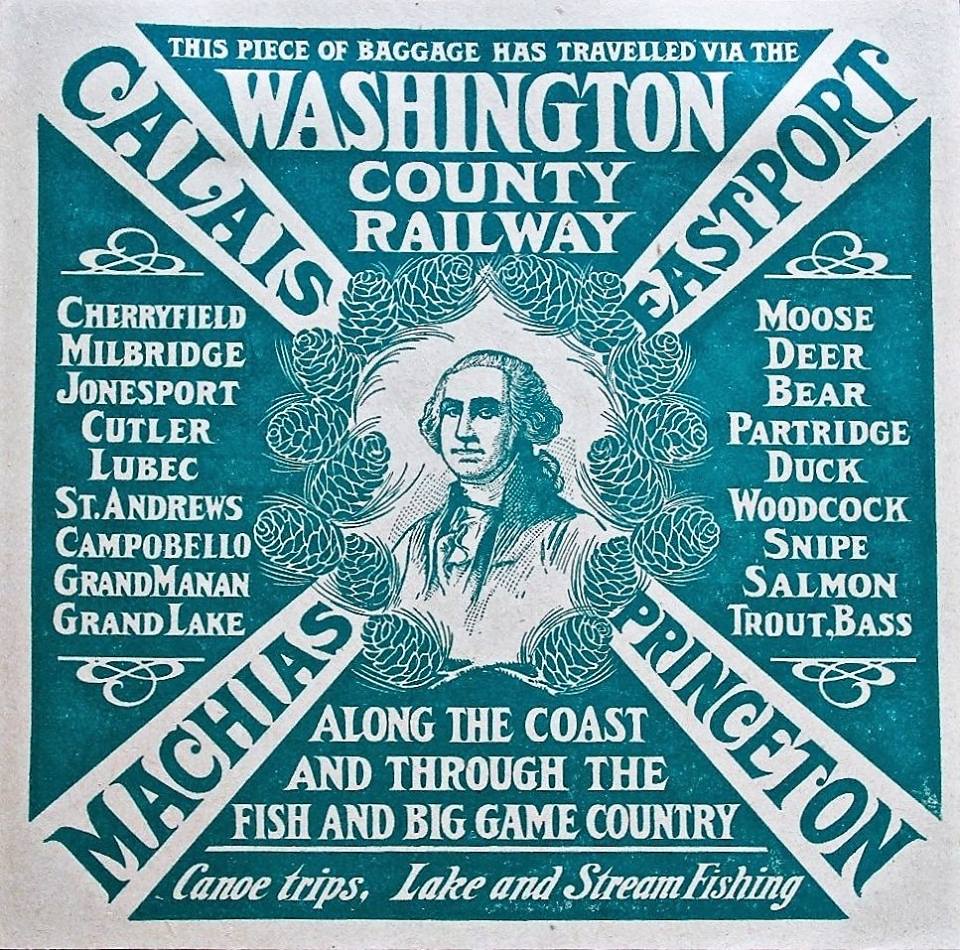
Luggage tag 1900 Washington County Railroad
Quote from its advertising brochure
Many years ago, the moose were plenty in Washington County as in any other region in Maine. But latterly they grew more and more scarce, until it became decidedly exceptional to hear of one being seen or shot hereabout.
But during the spring and summer preceding the hunting season of ninety-nine, moose began to be reported as having moved into the county, and many were seen all through the various towns. Hardly had the open season for moose begun when one was shot at Princeton by a native and resident of that place, and a week later a member of the Passamaquoddy tribe of Indians, who have a reservation on a long promontory stretching out into Big Lake, secured a second. Other moose were heard from in various parts of the county, and one was shot in the vicinity of Mopang Lake, and taken to Boston by its owner.
Now it is not the intention of the promoters and management of the Washington County Railroad to advertise this region as a moose country. On the other hand, we believe that the less the moose are hunted hereabout the better it will be for the game interests of the people of the county, of the visiting sportsmen, and of the transportation company.
There were periods in the early 1900’s when moose hunting was restricted or banned in Maine but the battles in the legislature over the issue were fierce:
Calais Advertiser November 4, 1914:
The coming of November brings the open season on moose in Maine and there will be a great influx of sportsmen from all parts of the country on the trail of the finest big game animal that remains on the American continent. The open season on deer began a month ago and will continue until the middle of December, but the moose hunters are allowed only a month, and it may be that this month will be the last in which Maine moose can be legally killed for a period of five years or more. While the supply of deer has apparently pretty well held its own, in spite of the slaughter of many thousands each fall, the moose have been decreasing in recent years at such a rate that the commissioners will urge a 5-year close time to protect them from extinction. There will be opposition, no doubt, before the legislature, but the commissioners usually have their way on such matters.
Finally in 1935 the hunting of moose in Maine was banned entirely.
The Canadians were not so quick to protect their moose population which led to the Princeton correspondent to the Advertiser in 1922 to complain:
There is a close season in Maine for moose until 1925. But New Brunswick hunters can come to the New Brunswick bank of the St. Croix River, which forms the dividing line, and call a moose across the river from Maine. He is then, to all intents and purposes, a New Brunswick moose, although he may have always had his citizenship in Maine and falls a trophy to a Canadian hunter. If, however, a Canadian moose is called across the river to the Maine side he is at once protected by Maine law from the sportsman’s rifle. Our hunters feel that some legislation should obviate this difficulty and they are ready to suggest a law to our legal solons.
The Canadians were soon to learn the folly of their position because an open season on moose drew all sorts of heavily armed “folks from away” across the New Brunswick border and produced stories such as this one in the 1928 St. Croix Courier:
Get Five Deer, Two Moose and Eagle
Two large automobiles with Massachusetts tags No. 375-518 and 379-314 came through St. Stephen one day last week from Saint John County. There were three men in the party and they had been on a hunting trip and had with them five deer, one a very large one, the heads of two moose and five quarters of moose meat. They also had a large eagle. It was quite a sight to see the cars with the game strapped on the running boards and tied on the rear of the cars and they made a splendid advertisement for New Brunswick as a game country.
Only in 1980 was moose hunting again allowed in Maine with 700 permits issued. This number has fluctuated over the years, increasing to as many as 4000 permits. The Canadians finally stopped the moose hunt entirely in 1936 as the moose population had collapsed and only in 1960 did it resume issuing a limited number of moose permits.
Click here for Part 2, in which we’ll explore some interesting and often humorous accounts from the St Croix Courier and other sources on human-moose interactions over the years.

